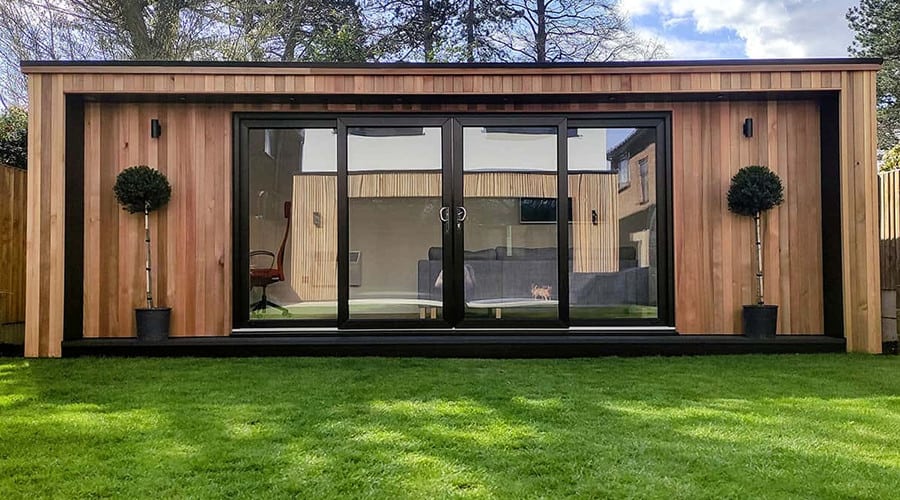Garden rooms have become increasingly popular in recent years as homeowners seek to expand their living spaces and create versatile areas for relaxation, work, and entertainment. These structures offer the perfect blend of indoor comfort and outdoor tranquility, allowing individuals to enjoy the beauty of nature while staying connected to their homes. One question that frequently arises among homeowners contemplating the addition of a garden room is whether they can attach it directly to their house. In this blog post, we will explore the possibilities and considerations surrounding attaching garden rooms to your house.
What is a Garden Room?
Before delving into the possibility of attaching garden rooms to houses, let’s define what a garden room is. Garden rooms are standalone structures designed to be a versatile extension of a home, offering a myriad of functions. They serve as an additional living space, a home office, an art studio, a gym, or even a guest room. Garden rooms are constructed with durable materials, insulated walls, and double-glazed windows, ensuring that they are comfortable and usable year-round. Unlike conservatories, garden rooms boast solid walls and are more energy-efficient, making them a preferred choice for homeowners looking for a seamless indoor-outdoor connection.
Can You Attach a Garden Room to Your House?
Yes, it is possible to attach a garden room to a house. However, there are certain factors that homeowners need to consider before proceeding with this kind of construction. Here are some essential aspects to keep in mind:
Planning Permission and Building Regulations
Before embarking on any construction project, it is vital to check local planning permission requirements and building regulations. In many cases, attaching a garden room to a house may require approval from the local planning authority. These regulations ensure that the structure adheres to safety and construction standards, protecting both the homeowner and the community. Failure to obtain the necessary permissions could result in fines or the requirement to remove the garden room.
Structural Considerations
Attaching a garden room to a house demands careful attention to structural considerations. The two structures must be securely and adequately connected to ensure stability and safety. It is advisable to engage a qualified structural engineer to assess the connection and suggest appropriate measures. The existing house’s foundations, load-bearing walls, and roof structure should be evaluated to ensure that the attachment does not compromise the overall integrity of the building.
Design and Aesthetic Integration
A well-designed garden room should harmonise with the existing architecture of the house. Consider the visual impact of the attached structure and how it integrates into the overall aesthetics of the property. Homeowners may choose to match the garden room’s exterior with the house, maintaining a cohesive appearance, or opt for a complementary design that accentuates the garden’s beauty.
Practicality and Functionality
An attached garden room should serve a practical purpose and complement the homeowners’ lifestyle. Consider the primary function of the space and how it will be used throughout the year. Adequate insulation, ventilation, and natural light sources should be incorporated to ensure a comfortable and inviting environment.
Drainage and Waterproofing
Proper drainage and waterproofing are essential when attaching a garden room to a house. This ensures that rainwater and moisture do not seep into the structure or the adjoining property. Properly installed guttering and downpipes can help manage rainwater effectively and protect both the garden room and the house from water-related damage.
Utility Connections
Depending on the garden room’s intended use, homeowners may need to extend utility connections such as electricity, heating, water, and internet to the attached structure. Planning for these connections during the design phase can prevent later challenges and ensure a seamless transition from the main house to the garden room.
Benefits of Attached Garden Rooms
There are numerous benefits to attaching a garden room to a house, which contribute to their growing popularity among homeowners:
Enhanced Living Space: An attached garden room expands the usable living area of the house, providing more room for various activities without the need for a full extension.
Increased Property Value: A well-designed garden room can add value to the property, making it more appealing to potential buyers.
Easy Access: Being connected to the main house means easy and convenient access to amenities like kitchen and bathroom facilities.
Natural Light: Attached garden rooms can benefit from the natural light that flows through the house, making the interior space brighter and more inviting.
Cost-Effective: Attaching a garden room to an existing house can be more cost-effective than building a standalone structure from scratch.
In conclusion, garden rooms can indeed be attached to houses, offering a versatile and attractive extension of the living space. However, homeowners must carefully consider planning permissions, building regulations, structural integrity, and aesthetic integration before proceeding with such a project. When done correctly, an attached garden room can significantly enhance a property’s value and lifestyle, providing a seamless indoor-outdoor connection that blends comfort and nature in perfect harmony.

